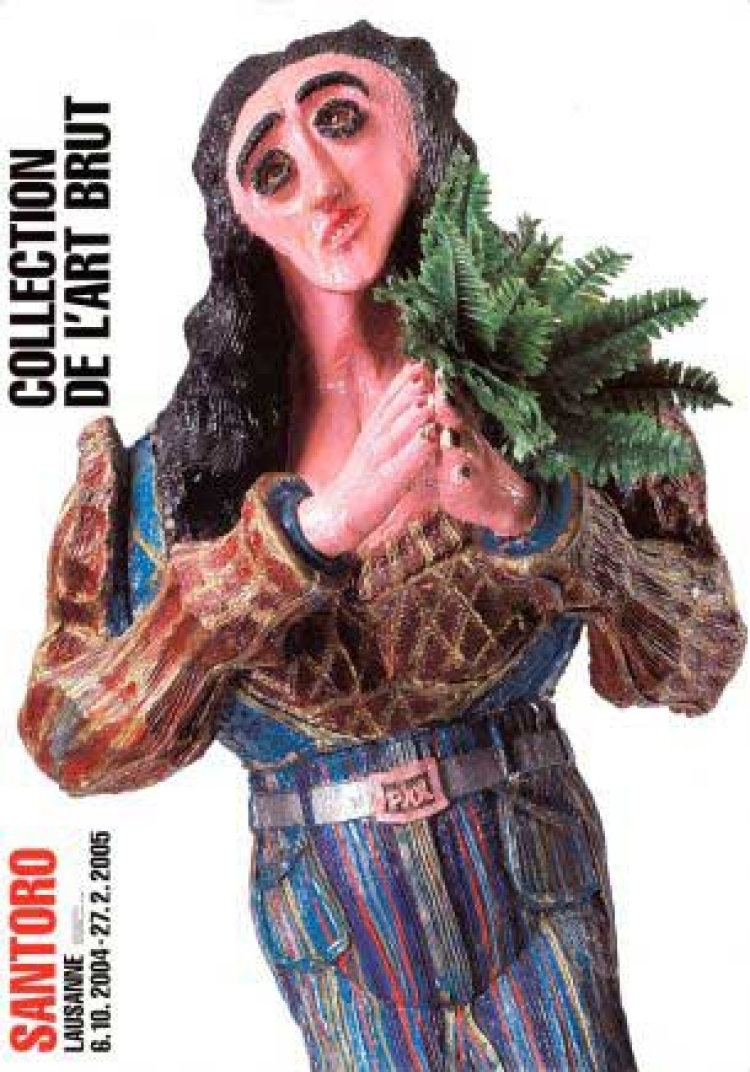Santoro - October 6, 2004 through February 27, 2005

Man, woman, horse, pig, camel, life-size. Eugenio Santoro makes large-format wooden sculptures representing animal and human figures. These works are similar to anamorphoses. With faces and features distorted, twisted heads and lop-sided postures, the bodies’ centre of gravity is disrupted by a new attraction: the viewer has the feeling of having trouble with his or her eyesight. Anatomical disequilibrium and distortion are the expression of an existential rupture in the artist, affecting the innermost depths of his being.
Santoro comes from southern Italy. He was born in Castelmezzano in 1920. After elementary schooling he was apprenticed to a carpenter. At the age of 20 he was called up and went to the front in Albania, then northern Greece, where the Italian forces suffered horrendous losses. Taken prisoner by the Germans, he was deported to the Lower Rhineland and spent two years in a forced labour camp. On his return to Italy he became a municipal employee, then opened a small carpenter’s workshop in the village. In 1964, aged 44, forced into emigration, he fled from the extreme poverty of southern Italy and settled in Switzerland together with his wife. Santoro was hired as a labourer in a factory in the valley of Saint-Imier, in the Jura, at that time undergoing full industrial development.
The experiences of the war and of deportation, the camps, hunger, destitution, then exile have left their definitive mark on Santoro.
However, he did not resign himself in silence. He retaliated symbolically by sculpting, in his garden, the trunks of fruit trees that he salvaged. The moral breach that he endured can be read in the physical distortion to which his human and animal figures are subjected, bringing some of them close to collapse. The figures – each of which has its head turned – express through this movement their look back towards an obsessive, sombre, humiliating, crushing past.
Small and slight in stature, wasted by his trials and tribulations, Santoro has brought to life in wood Le Géant (The Giant). As for Maria Maddalena (Mary Magdalene) or La Femme assise (Seated Woman), these works evoke his daughter, who seems to occupy all his thoughts; they constitute a poetic and sensuous revenge for the tragedy of his life.
Santoro takes particular care of all his statues. He clothes them, decks them out with accessories, sometimes paints them, and coats them with varnish. Once a creation has been completed in his open-air workshop, the artist makes each of them take the path to the cellar which serves as their shelter. There they are wrapped up and protected like faithful accomplices. Santoro’s work is that of a sublime, pacifistic rebellion.
The Collection de l’Art Brut presents sculptures, paintings and drawings from its holdings as well as works from the artist and from private and public collections. Our heartfelt thanks are due to Eugenio Santoro and his family, and to lenders and donors for their important contribution. In addition, the exhibition will offer photographs by Mario del Curto and a film by Dominique Clément, inviting the public to explore the personal world of the artist.
Santoro comes from southern Italy. He was born in Castelmezzano in 1920. After elementary schooling he was apprenticed to a carpenter. At the age of 20 he was called up and went to the front in Albania, then northern Greece, where the Italian forces suffered horrendous losses. Taken prisoner by the Germans, he was deported to the Lower Rhineland and spent two years in a forced labour camp. On his return to Italy he became a municipal employee, then opened a small carpenter’s workshop in the village. In 1964, aged 44, forced into emigration, he fled from the extreme poverty of southern Italy and settled in Switzerland together with his wife. Santoro was hired as a labourer in a factory in the valley of Saint-Imier, in the Jura, at that time undergoing full industrial development.
The experiences of the war and of deportation, the camps, hunger, destitution, then exile have left their definitive mark on Santoro.
However, he did not resign himself in silence. He retaliated symbolically by sculpting, in his garden, the trunks of fruit trees that he salvaged. The moral breach that he endured can be read in the physical distortion to which his human and animal figures are subjected, bringing some of them close to collapse. The figures – each of which has its head turned – express through this movement their look back towards an obsessive, sombre, humiliating, crushing past.
Small and slight in stature, wasted by his trials and tribulations, Santoro has brought to life in wood Le Géant (The Giant). As for Maria Maddalena (Mary Magdalene) or La Femme assise (Seated Woman), these works evoke his daughter, who seems to occupy all his thoughts; they constitute a poetic and sensuous revenge for the tragedy of his life.
Santoro takes particular care of all his statues. He clothes them, decks them out with accessories, sometimes paints them, and coats them with varnish. Once a creation has been completed in his open-air workshop, the artist makes each of them take the path to the cellar which serves as their shelter. There they are wrapped up and protected like faithful accomplices. Santoro’s work is that of a sublime, pacifistic rebellion.
The Collection de l’Art Brut presents sculptures, paintings and drawings from its holdings as well as works from the artist and from private and public collections. Our heartfelt thanks are due to Eugenio Santoro and his family, and to lenders and donors for their important contribution. In addition, the exhibition will offer photographs by Mario del Curto and a film by Dominique Clément, inviting the public to explore the personal world of the artist.
Practical Information
Dates
October 6, 2004 to February 27, 2005Private view Tuesday October 5, 2004, 18:30
Curator
Lucienne PeiryAccessibility
The exhibition Santoro is not accessible to people with reduced mobility.